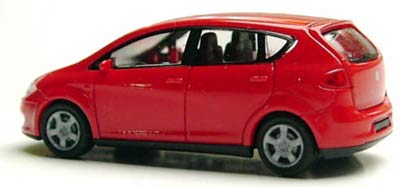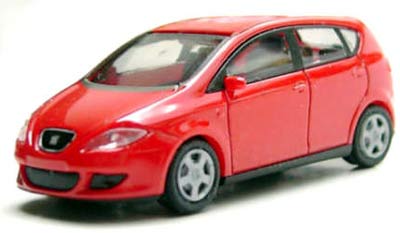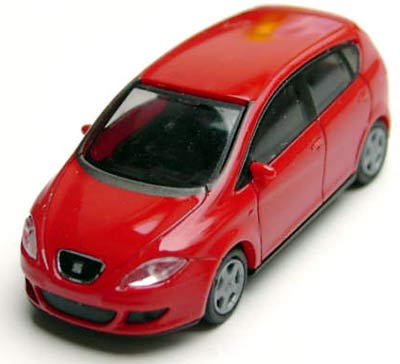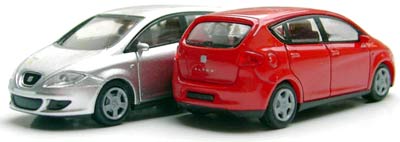When Rietze published pictures of the new SEAT Altea minivan on their
website a couple of days ago, I was happy to see the model much, much
earlier than I had hoped Rietze would have been able to have the tooling
ready. I was even happier when I sent them an e-mail with a list of
questions and received a response in the form of a pair of promotional
models, with the polite implication these might serve as material for
a review. I was most happy to take the hint.


Introducing the Altea as a design study at last year’s Frankfurt
Auto Show, SEAT earned many smiles – they had done a 2+2-seater
minivan! It would become the first production car to bring SEAT’s
slogan “auto emoción” to life: Unlike its Volkswagen
brother, the Touran, SEAT certainly did not forget to style the Altea.
Earlier design studies they had brought to various motor shows proved
SEAT designers were capable of drawing beautiful lines, but the cars
they actually sold, while always good, were a bit unimaginative: So
very Volkswagen; so little Hispanic heat.
Although the Altea was marked as a design study, SEAT announced the
street version would differ only in details. They kept their promise.
The 2004 Altea had to give up the study’s huge show car wheels
and got one more seat for practicality, but about everything else made
it into production – even the A-pillar housed windscreen wipers.
Not by coincidence, the car’s lines look more than faintly familiar:
SEAT’s new design director, Walter de’Silva, used to draw
the stunning shapes of Alfa-Romeos. And we are promised the lines will
be carried on by future SEATs.

Essentially, the Altea is a compact car based on the new Volkswagen
Golf Mk5’s platform (shown above, left for comparison). It carries
over its brother’s
wheelbase of 8 feet, 5.5 inches (2.578 meters). Lengthwise, it sits
right between
the Golf and the other Golf-based people-carrier, the Volkswagen Touran
(which sits on a longer wheelbase). The engines, inline-fours all of
them, range from 102hp to 150hp for the time being, among these Volkswagen’s
newest direct-injection FSI petrol (gasoline) and TDI diesel motors.
The times when Seat had to make do with previous-generation diesels
are
history
now.
To most Americans, the SEAT brand will be unknown. The acronym stands
for Sociedad Española de Automóviles de Turismo S.A.,
or Spanish Touring Car Corporation. SEAT was founded in 1950 by the
State of Spain, with production starting three years later: The first
car ever to wear the SEAT badge was called the 1400, just like the
FIAT sedan it copied in almost every other detail. With the idea in
mind to make a set of wheels affordable for the average factory worker,
an idea a certain Henry Ford had brought to perfection before, SEAT
had acquired a license and started to manufacture FIAT subcompacts
rather than import them. The little 1957–1973 SEAT 600 would
be the first set of wheels for many a Spaniard. One after another,
even larger FIAT cars were produced at the Zona Franca plant in Barcelona.
Planning to make SEAT a publicly-owned company, FIAT was bought out
by the state in 1981. As the long-term strategy was to establish a
strong, independent brand, the new owners sought partners with a reputation:
Italian master designer Giorgio Giugiaro, Porsche’s design and
development center, and Karmann coachbuilders all did their part in
bringing the first Ibiza to live in 1984. It would become the first
SEAT not based on a FIAT model. From 1982 on, Volkswagen had SEAT assemble
Passat and Santana sedans in Barcelona and Polos at their Pamplona
site. Only four years later, Volkswagen purchased the majority of stock.
It would take until 1991 for the first SEAT to make extensive use of
Volkswagen parts – the Toledo.
That Toledo Mk1 was soon joined by the first new 1/87th scale SEAT
in years, made by AWM. At that time, there were only a couple of older
SEATs available from Eko, plus a few FIATs that required very little
work to badge them as SEATs. However, it took until 1997 to see other
current SEAT models. AWM won the promotional contract and developed
the Arosa minicar while Herpa made the Cordoba SX three-door subcompact
and the Alhambra minivan that, like the Ford Galaxy, was a clone of
Volkswagen’s Sharan. Only a year later, AWM made the Toledo Mk2
sedan for SEAT. It was only in 2004 that SEAT decided they needed promotional
models once again. This time, they asked Rietze.
Rietze surprised everyone – and pleasantly so – by announcing
the Altea MPV at the 2004 Nuremberg Toy Fair. Although they could not
show any samples in February, Rietze explained the model would be available
soon, as SEAT had asked that the models be available for the prototype’s
dealer presentation. And Rietze delivered. In mid-June, the first pictures
appeared at the Rietze website (www.rietze.de); immediately afterwards,
I received a parcel with two models to be reviewed; the result of which
you are currently reading.

It is always excellent news to get a model of a prototype that is
not part of the German car makers’ range. As most scale cars
nowadays result from industry underwriting, and the German makers appear
to be the only ones to be interested in 1/87th scale, the selection
of vehicles tends to cover everything Volkswagen, Mercedes, Audi, or
BMW produce – but we are missing so many other nice automobiles
that are available as prototypes.

So, it’s good that the model is there, but is it a good model?
Yes, definitely, despite some drawbacks. SEAT required an inexpensive
model to be used as a giveaway. Hence, it comes without a free-standing
interior mirror or chrome-plated parts. However, Rietze went so far
to paint even the non-metallic version! The paint job is improving,
but unfortunately, Rietze has not yet reached Wiking’s particularly
high standards. On the other hand, the metallic version pleases the
viewer with an additional layer of clear coating to equal the real
cars’ paint gloss. The tooling is crisp and clean, with engravings
being clearly visible even under a layer of paint or two. The model
as a whole neatly follows the prototype’s theme. Perhaps the
dramatically carved edge on the car’s side panels could have
been modeled more prominently on the scale car. While transparent inserts
for head- and taillights are common practice today, Rietze’s
ability to tightly fit windows into a model’s body must be praised
with each of their models. The windscreen’s sealing is printed
on both the glass part and the body to catch the prototype’s
style. The prominent logo and model name on the backdoor have not been
omitted, and the front grille insert comes with a logo and silver frame
as well. Although the wheels are see-though parts, Rietze once again
managed to let them look too small – despite the 16 scale inches
they measure are dead on compared to the prototype’s rims. On
a model, larger wheels always make for a less toylike impression. Maybe
Rietze will learn that lesson one day. As for the interior, it is a
rather simple one-piece part, but all important aspects of the prototype
have been dealt with. As the interiors are always molded in black,
further attention to detail would go unnoticed anyway – and Rietze
does not annoy collectors with a molded-in steering wheel as the market
leader tries every now and then…
My wish list for Rietze is short: Give it larger wheels and keep on
working on the paint job; perhaps try to design and fit the lights
as neatly as the windows. Apart from that, please continue to model
the occasional prototype the larger players will ignore. And thanks
for such a nice addition to any European scale car collection!
Marc Schmidt |